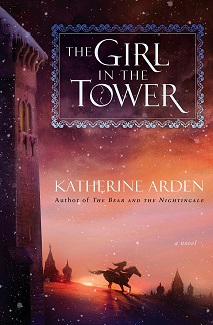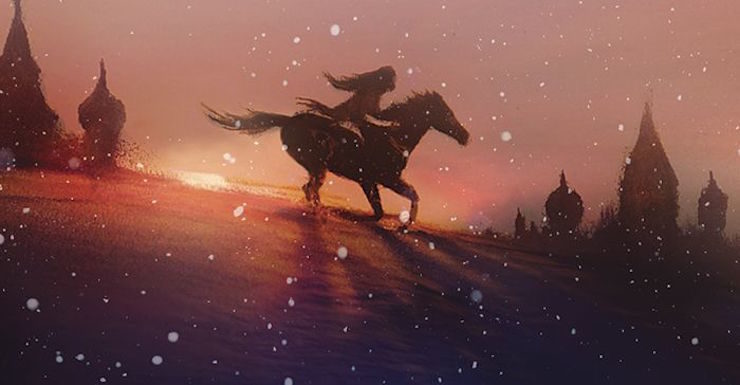Katherine Arden’s The Girl in the Tower picks up right where The Bear and the Nightingale left off, with Vasya Petrovna on the run with her magic stallion Solovey. Disguised as boy—respectable girls cannot travel safely alone in 14th century Russia—she is determined to see the sea and explore the world. Along the way she collides with a gang of well-equipped bandits burning villages to the ground and kidnapping young girls.
At the same time, Vasya’s brother Aleksander, now a highly respected monk in Moscow, and Grand Prince Dmitrii set off to investigate the raids at the behest of a strange new boyar calling himself Kasyan. The men’s path soon intertwines with Vasya’s, making her gender-bending ruse all the more risky.
Further complicating matters is her growing bond with Morozko the frost demon. Neither of them quite know where their relationship is headed, but whatever the destination, the journey there is sure to be fraught.
Buy the Book


The Girl in the Tower: A Novel (Winternight Trilogy)
If The Bear and the Nightingale was a fairytale about a girl caught in the middle of a battle between two old gods, The Girl in the Tower is a coming-of-age story about a young woman figuring out what she wants from life. Vasya is a child no longer a child but not quite an adult, despite what some creepy boyars think. She has a lot of big decisions to make, and she’ll have to live with the consequences for the rest of her life, no matter how short that happens to be.
I absolutely adored Vasya, but as a middle-aged woman I think I relate to Olga the most. We’re nothing alike, personality-wise, but I get her now in a way I couldn’t when I was Vasya’s age. When you’re young, it’s hard to understand why anyone would willingly settle for something they didn’t want. But as you age you start making choices—take a job you don’t love because you have to provide for your kids, live somewhere boring because it’s cheaper than somewhere exciting, set aside some of your dreams and do the practical thing. We can’t all always be Vasyas. Sometimes you have to be an Olga.
There’s romance in the Winternight Trilogy, of course. What fairy tale doesn’t have a love story between a beautiful young maiden and a grumpy monster? But Arden infuses hers with mutual respect. As Vasya and Morozko get more and more intimate, they never forget that she is barely 16 and he’s ancient and immortal. He wants her to make the prudent choice, even if that means dumping him, and she wants to make her decision based on the truth of their relationship.
The concepts of feminism and equity don’t exist in Vasya’s world, but she believes in them anyway. She will not kneel for a man, nor will she permit a man to force her to kneel. She will make her own destiny and push back against those who would stop her. Yet Arden never stereotypes her down to a Strong Female Character. Vasya’s extreme reactions are in direct proportion to her extreme circumstances. As a high-ranking woman, her only options are the terem to live out her days as a broodmare for some dull boyar or the convent to grovel to the new god and reject the old ones. By rejecting both, she’s declared a witch and her life is suddenly forfeit, but she still will not be cowed.
My only real complaint is how pervasively cishet and white the series is. Vasya is secure in her gender identity even as she crossdresses, but what would her confidence look like if she met a trans person, one who either envied Vasya’s ability to change her gender presentation or one who had already transitioned? Think about the intersectional context that would add to the series. For characters who already exist, it’d be pretty easy to reveal one of them as queer. If Sasha were gay, for example, that would add layers to his reaction against Vasya breaking tradition. As it stands, his reaction is rooted in the patriarchy, but what if instead he was processing through a life spent in the closet? There’s his younger sister pushing back against gender roles where he can’t or won’t.
In terms of race, medieval Russia wasn’t a teeming hub of ethnic diversity, but it also wasn’t exclusively white. Saint Demetrios was historically depicted as African, so it’s not like medieval Russia was unfamiliar with brown people. Icons of John the Baptist often depicted him with dark skin. Not to mention the brown-skinned Saints Nicholas, Theodore Stratelates, and Theodore Tyron, all from Asia Minor. The Vikings ran trade routes through Russia to Asia, and the Eurasian Steppe Route acted as the northern branch of the Silk Road. The Russians themselves operated a fur trade that ran down the Baltic Sea and out to Western Europe, and the Volga trade route which extended from Scandinavia to the Byzantine Empire. They were still paying tribute to the descendants of Genghis Khan. Getting hassled by Tartars (people ethnically related to Turks and Mongols) is a key plot point of The Girl in the Tower, for Baba Yaga’s sake. And yet Arden never describes them as people of color, so if you don’t already know they’re POC there’s no reason for you think they’re anything but white.
The lack of diversity isn’t just annoying, it’s unrealistic. I’ll say it again for the people in the back: medieval Europe was never all white, cis, or straight. Writing the Winternight Trilogy with diversity wouldn’t alter the plot by much but would add texture and make the experience that much richer. But at the end of the day, this is a fantasy book with frost demons, house spirits, and wicked wizards. If your imagination can handle ghosts but not people of color or queer people, then we have a problem.
I must also offer a content warning for sexual assault. The first book discusses marital rape that while not graphically violent is clearly non-consensual; in the second, a man gropes and forcibly kisses a young woman and threatens to kill her family if she doesn’t comply. There’s also a looming threat to Vasya from a cruel priest who wants to horrific things to her.
All too often, stories featuring sexual violence reduce it to a plot device or as motivation for a vengeful man (*side eyes* Game of Thrones), but that isn’t the case here. Both assaults are framed with the female victims’ emotional impact as the focal point. We see these assaults to understand what it’s like to be a woman in a world as patriarchal as medieval Russia. Each victim responds very differently to their assaults, but neither response is valued as any better or worse than the other. Every woman in this world exists on a spectrum of sexual violence and subjugation, even brave, bold Vasya. I did not read these incidents as exploitative, but as moments where each woman defined herself, either by carving out a life in a place that didn’t want her or by plotting her revenge. YMMV, of course.
I enjoyed The Bear and the Nightingale more than the last Tor.com reviewer, but that may be because I read it and The Girl in the Tower back to back. With just the first book, interesting characters vanish midway through and are never referenced again, but a binge read lessened that loss. Reading the novels within the framework of a trilogy rather than as individual books helps eases some of the wonkier elements. But if the first book’s vanishing acts don’t work for you, then you’ll probably also struggle with The Girl in the Tower. When Vasya leaves Lesnaya Zemlya, she really leaves. Everyone left behind drops out of the text more or less completely. But, again, it wasn’t a problem for me. There’s no realistic way Vasya herself could have kept up contact with her relations, and they don’t have anything to do with the story except when their lives intersect with Vasya’s.
The Winternight Trilogy is romantic in every sense of the word. Arden weaves a fireside tale full of heartless lies, political schemes, and winter magic. It’s a haunting, heady series, cold but not lifeless story set in a land frozen by snow and oppression. The characters are vividly drawn and intriguing. Fans of Russian folklore will recognize most of the players, but the story is straightforward enough for those wholly unfamiliar. Even with all the contextual issues noted above, I still loved The Bear and the Nightingale and The Girl in the Tower. They burrowed under my skin in a way few books have. If you’re looking for a book to read on a rainy day with a cuppa and a blanket, the Winternight Trilogy is just the thing.
The Bear and the Nightingale and The Girl in the Tower are available from Del Rey.
Alex Brown is a teen librarian, writer, geeknerdloserweirdo, and all-around pop culture obsessive who watches entirely too much TV. Keep up with her every move on Twitter and Instagram, or get lost in the rabbit warren of ships and fandoms on her Tumblr.











This is a wonderful, thoughtful review, and I really enjoyed it. I strongly agree that making Sasha gay would really have added depth to his character, and that would probably have been preferable to the Konstantin/Medved dynamic that we got instead. I’d be curious to hear your opinion!
I don’t think it’s entirely fair to say Arden loses points for POC representation when the Tatars are exactly that. If your contention is “if you don’t already know they’re POC there’s no reason for you to think they’re anything but white”, I’d be inclined to say that’s kinda more on the reader than on Arden. Most of the Slavic world was under what’s called “The Mongol/Tatar Yoke” for about 250 years (1237-1480) and it’s a huge deal in their history. Tatar khanates were really influential political and military entities in E. Europe (not to mention the Ottoman world) up until the 17th century, and the last Tatar khanate existed until 1847. There are c.6,800,000 ethnic Tatars today, and when Russia annexed Crimea in 2014 a lot of the indigenous Crimean Tatar population were forcibly relocated and there are ongoing human rights issues. (Sorry for the infodump)
Not trying to say “omg how did you not know this” but I hope this helps contextualize where the book was coming from. It’s not super unreasonable to expect people to know some of this.
Maybe Arden should’ve spent more time making it explicitly clear the Tatars aren’t white, but if she didn’t go with the political and ethnic identification “Tatar”, she’d have to fall back on physical descriptors or on highlighting religious differences. And given the nasty legacy of period lit portraying the Tatars as [Orientalist descriptor here] + threats to white Christendom, I’d argue that Arden was doing her best with a very fraught subject.
Anyhow, this was a great review and I really look forward to reading more of your stuff!